If a tire goes flat, avoid further tire and wheel damage by driving slowly to a level place. Turn on your hazard warning flashers.
Caution: Changing a tire can be dangerous. The vehicle
can slip off the jack and roll over or fall on you or other people. You and they could
be badly injured or even killed. Find a level place to change your tire. To help prevent
the vehicle from moving:
To be even more certain the vehicle will not move, you should put blocks at
the front and rear of the tire farthest away from the one being changed. That would
be the tire, on the other side, at the opposite end of the vehicle.
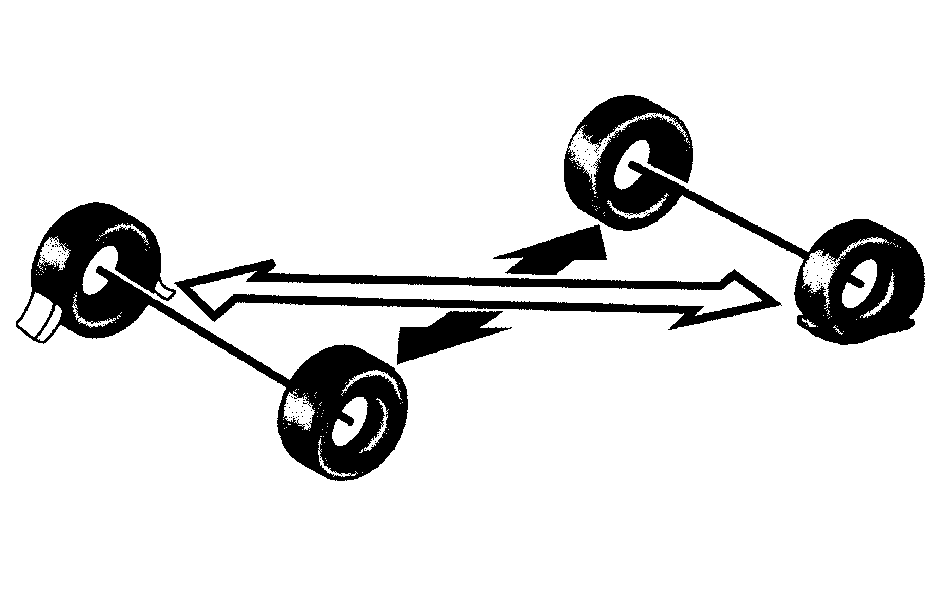
The following steps will tell you how to use the jack and change a tire.
Removing the Spare Tire and Tools
The jacking equipment is located behind the rear seatback on the passenger's side of the vehicle.

Wheel Wrench
Bracket
Jacking Instructions (Roll and place tag behind the bracket after the tools are installed.)
Bolt Location
Wheel Blocks
Wing Nut
Rubber Band
Jack Position
- To remove it, turn the plastic wing nut (F) counterclockwise. Remove the jack cover.
- Turn the wing nut counterclockwise and remove the wheel blocks, jack and wheel wrench.
- Be sure the chisel end of the wheel wrench connects into the hoist shaft.
- Turn the wheel wrench counterclockwise to lower the spare tire. Keep turning the wheel wrench until the spare tire can be pulled out from under the vehicle.
- When the tire has been completely lowered, tilt the retainer at the end of the cable and pull it through the wheel opening.
- Pull the tire out from under the vehicle.
- Put the spare tire near the flat tire.
Notice: If you remove or restow a tire from/to the storage position under the vehicle when it is supported by a jack, you could damage the tire and/or your vehicle. Always remove or restow a tire when the vehicle is on the ground.
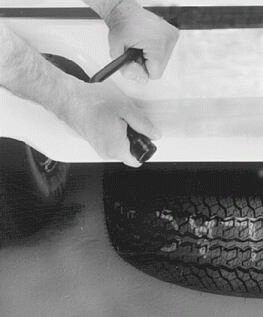
Insert the chisel end of the wheel wrench, on an angle, into the hole in the rear bumper.
If your vehicle is equipped with a compact spare tire, it is stowed underneath the rear of your vehicle. See Compact Spare Tire
Notice: If you drive away before the spare tire or secondary latch system cable has been reinstalled, you could damage your vehicle. Always reinstall this cable before driving your vehicle.
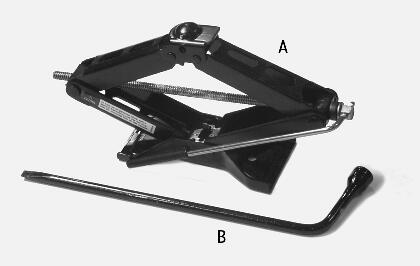
The tools you'll be using include the jack (A) and wheel wrench (B). Your vehicle may also have an optional hub cap removal tool.
Removing Wheel Covers
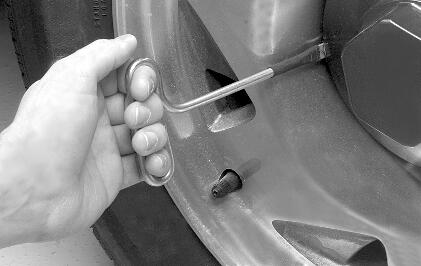
Position the bent end of your hub cap removal tool (shown), or the chisel end of your wheel wrench, in the notch of the hub cap and pry off the hub cap.
Some of the molded plastic hub caps have imitation wheel nuts molded into them. The wheel wrench won't fit these imitation nuts, so don't try to remove them with the socket end of the wheel wrench.

If you have individual wheel nut caps that cover each nut, they must be removed in order to get to the wheel nuts. Use the socket end of the wheel wrench to remove the wheel nut caps.
Your wheel nut caps may attach your hub cap to the wheel. Remove these wheel nut caps before you take off the hub cap.
Removing the Flat Tire and Installing the Spare Tire
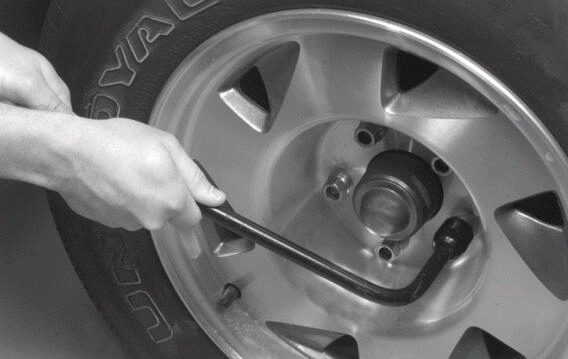
- Using the wheel wrench, loosen all the wheel nuts. Don't remove them yet.
- Turn the jack handle clockwise slightly to raise the jack lift head.
- Fit the jack into the appropriate hole nearest the flat tire.
- Raise the vehicle by turning the jack handle clockwise. Raise the vehicle far enough off the ground so there is enough room for the spare tire to fit underneath the wheel well.
- Remove all the wheel nuts and take off the flat tire.
- Place the spare on the wheel mounting surface.
- Tighten each nut by hand until the wheel is held against the hub. If a nut can't be turned by hand, use the wheel wrench and see your dealer as soon as possible.
- Lower the vehicle by turning the jack handle counterclockwise. Lower the jack completely.
- Use the wrench to tighten the wheel nuts firmly in a crisscross sequence as shown.
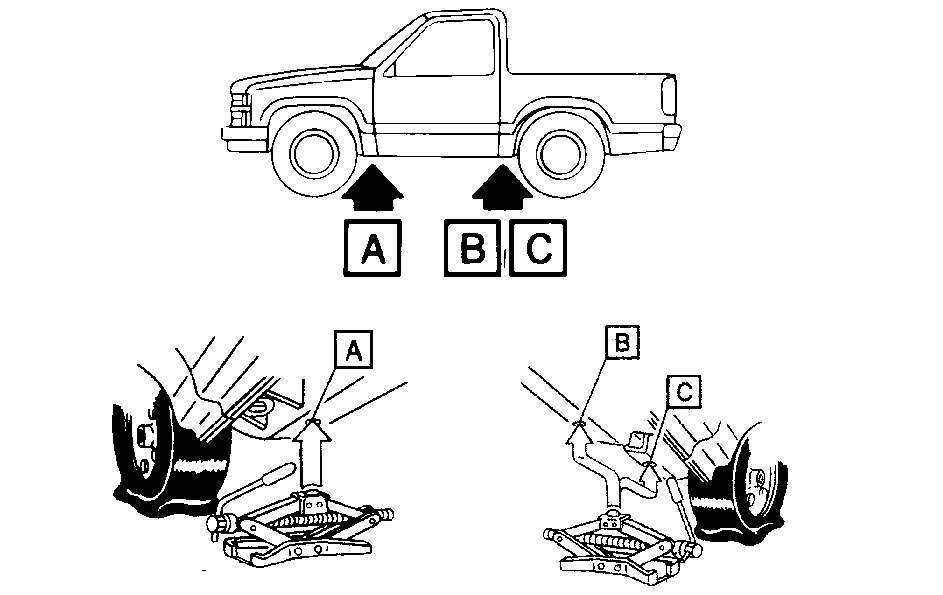
Front Frame Hole
Rear Frame Hole (ZR2)
Spring Hanger Hole (Standard Pickups)
| Caution: Getting under a vehicle when it is jacked up is dangerous. If the vehicle slips off the jack you could be badly injured or killed. Never get under a vehicle when it is supported only by a jack. |
| Caution: Raising your vehicle with the jack improperly positioned can damage the vehicle and even make the vehicle fall. To help avoid personal injury and vehicle damage, be sure to fit the jack lift head into the proper location before raising the vehicle. |

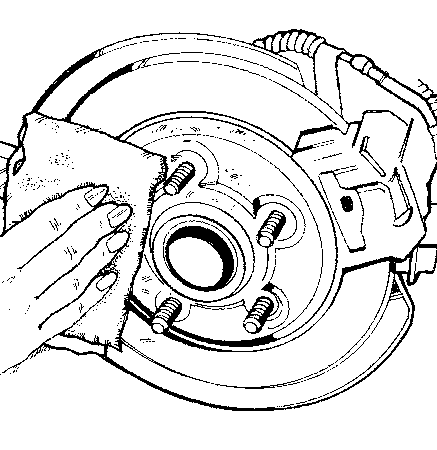
Remove any rust or dirt from the wheel bolts, mounting surfaces and spare wheel.
Caution: Rust or dirt on a wheel or other parts to which it is fastened, can make the wheel nuts become loose and eventually the wheel could come off and cause a crash. Always remove all rust and dirt from wheels and other parts.
Caution: Never use oil or grease on bolts or nuts because the nuts might come loose. The vehicle's wheel could fall off, causing a crash.
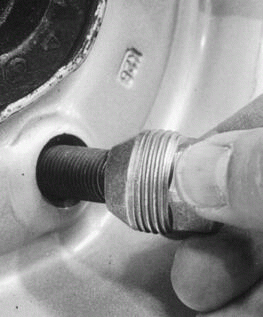
Put the nuts on by hand. Make sure the cone-shaped end is toward the wheel.
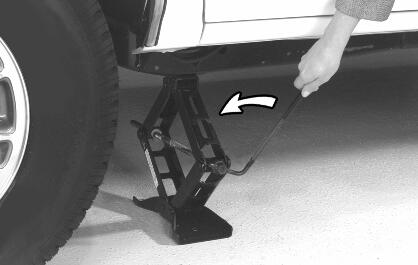
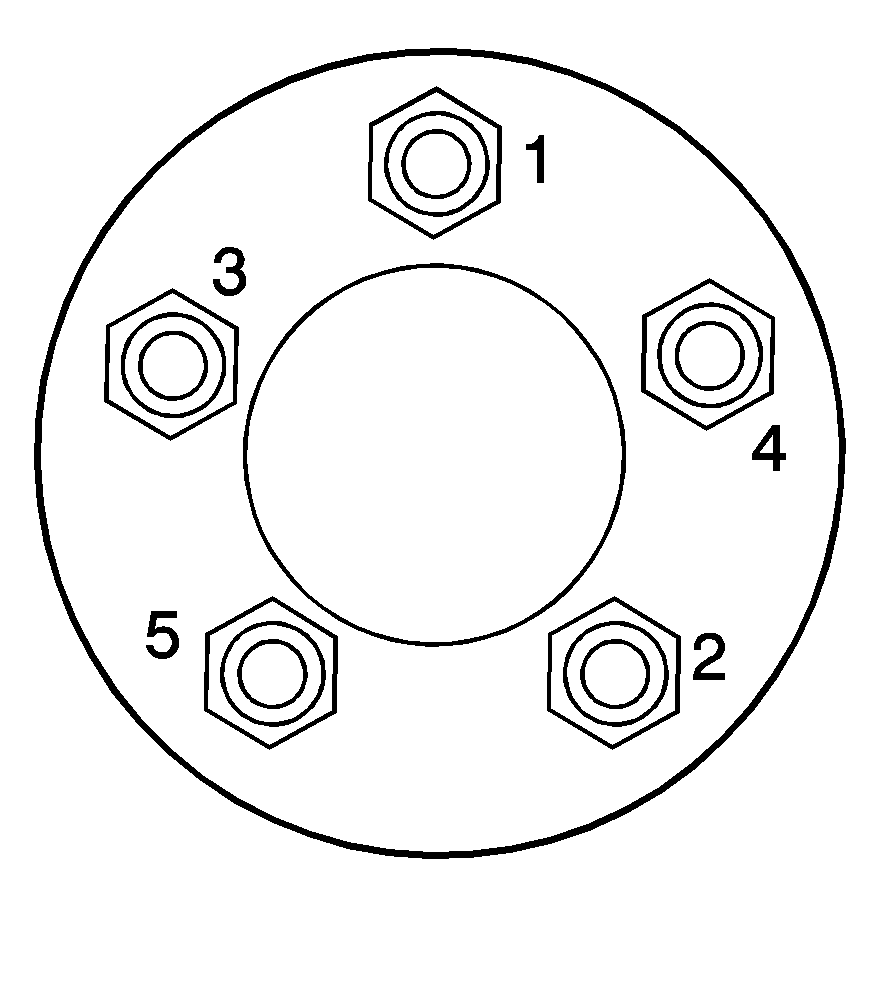
Caution: Incorrect or improperly tightened wheel nuts can cause the wheel to come loose and even come off. This could lead to a crash. If you have to replace them, be sure to get new original equipment wheel nuts. Stop somewhere as soon as you can and have the nuts tightened with a torque wrench to the proper torque specification. See Capacities and Specifications for wheel nut torque specification.
Notice: Improperly tightened wheel nuts can lead to brake pulsation and rotor damage. To avoid expensive brake repairs, evenly tighten the wheel nuts in the proper sequence and to the proper torque specification. See Capacities and Specifications for the wheel nut torque specification.
Storing a Flat or Spare Tire and Tools
Caution: Storing a jack, a tire, or other equipment in the passenger compartment of the vehicle could cause injury. In a sudden stop or collision, loose equipment could strike someone. Store all these in the proper place.
Notice: An aluminum wheel with a flat tire should always be stored under the vehicle with the hoist. However, storing it that way for an extended period could damage the wheel. To avoid this, have the tire repaired as soon as possible.
Follow this diagram to store the underbody-mounted spare.

Wheel Wrench
Hoist Assembly
Retainer
Spring
Tire
Valve Stem (Pointed Down)
Lower
Raise
- Put the tire on the ground at the rear of the vehicle, with the valve stem pointed down and to the rear.
- Pull the retainer through the wheel.
- Put the chisel end of the wheel wrench, on an angle, through the hole in the rear bumper and into the hoist shaft.
- Raise the tire fully against the underside of the vehicle by turning the wrench clockwise until you hear two clicks or feel it skip twice. The spare tire hoist cannot be overtightened.
- Make sure the tire is stored securely. Push, pull, and then try to rotate or turn the tire. If the tire moves, use the wheel wrench (A) to tighten the cable.
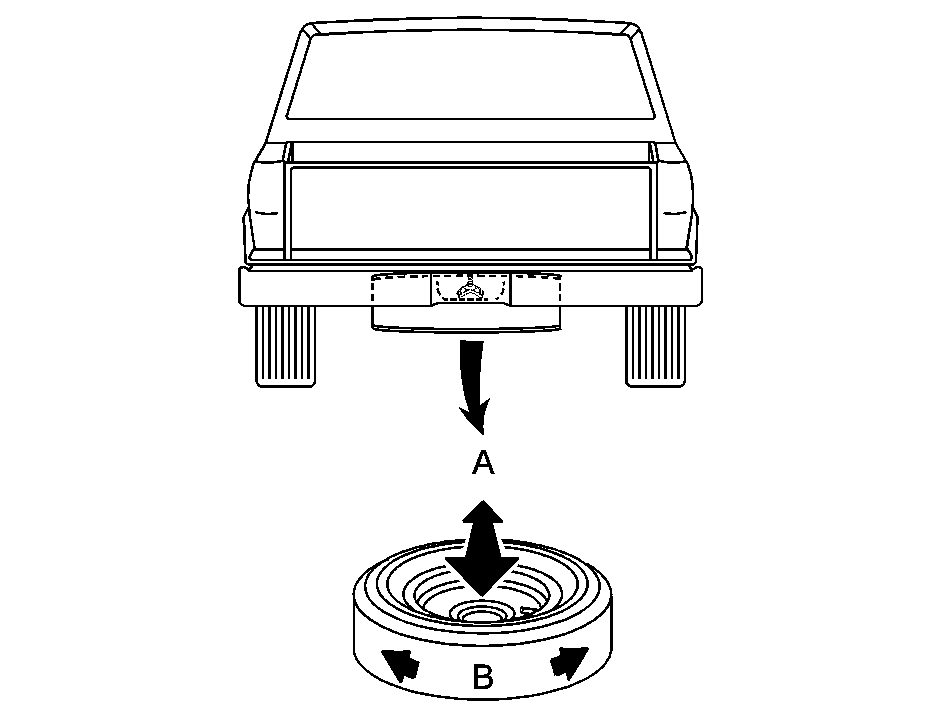
Return the jack, wheel wrench and wheel blocks to the proper location behind the seat. Secure the items.

Wheel Wrench
Bracket
Jacking Instructions (Roll and place instructions behind the bracket after the tools are installed.)
Bolt Location
Wheel Blocks
Nut
Rubber Band
Jack Position
Put the jack cover back on, if you have one.
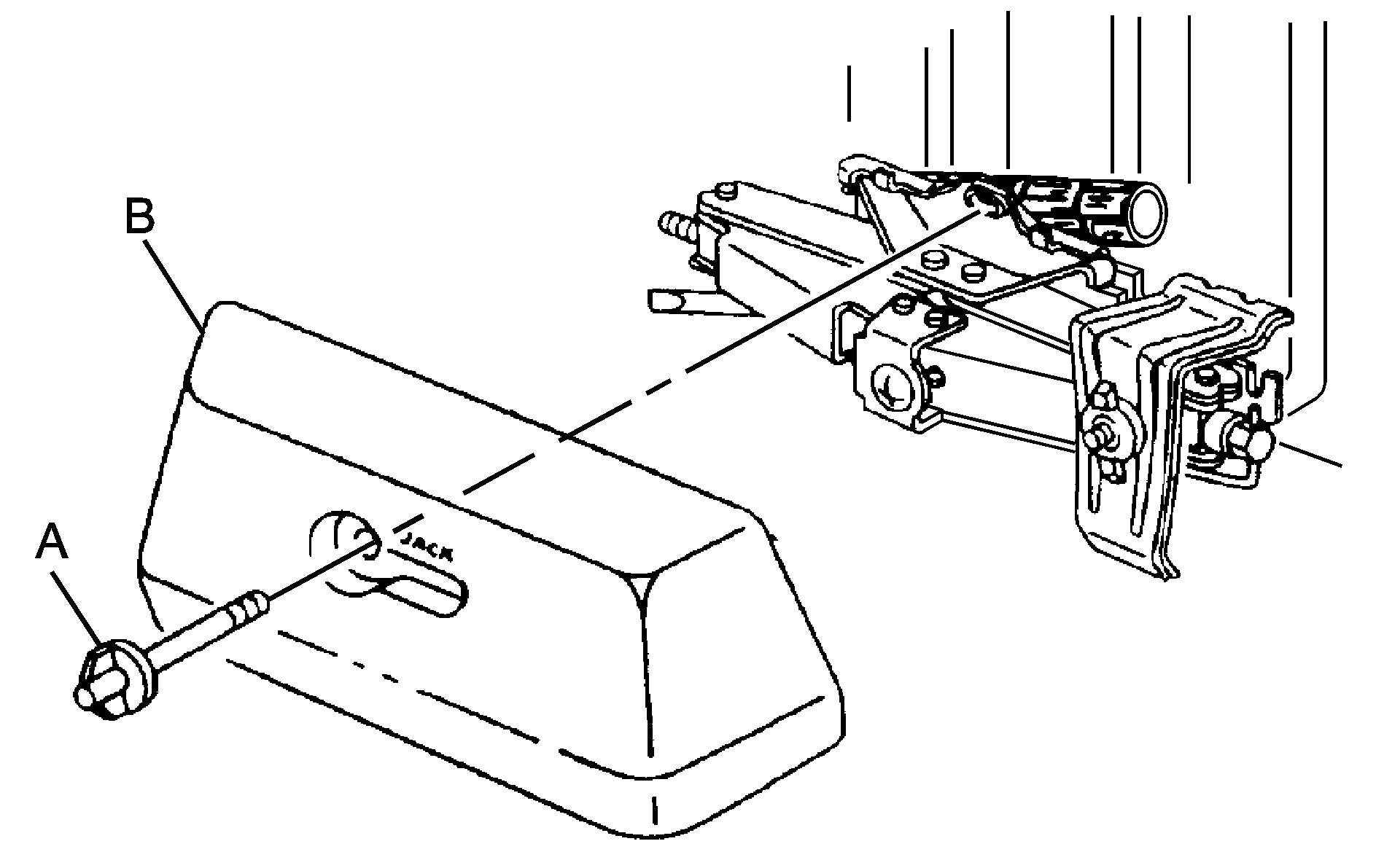
Bolt
Cover
